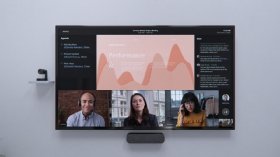
Microsoft adds end-to-end encryption to Teams
Microsoft will allow Teams users to make one-on-one, end-to-end encrypted video calls. The feature comes with tradeoffs, like no live captioning, recording or transcription.
Microsoft has released end-to-end encryption for one-on-one Teams calls, adding a feature already offered by competitors Zoom and Webex.
Microsoft this week made E2EE generally available to Teams users on Windows and Mac computers, allowing workers to secure calls so only the participants have access to the content. Usually, Teams secures data through Transport Layer Security encryption, in which data can be decrypted in Microsoft's cloud before being re-encrypted and sent to the intended recipient.
Because E2EE removes Microsoft's ability to access meeting data, customers' employees can't use cloud-based services when using the feature. The company said workers would be unable to record, capture or transcribe meetings while E2EE is on. Transferring calls, merging calls, adding a meeting participant and moving calls onto another device will not work either.
The feature is more limited than the E2EE offered by Microsoft competitors. While Teams E2EE calls are limited to two workers, Zoom and Webex allow encrypted meetings with multiple participants.
E2EE will make Teams more attractive to customers in highly regulated fields, like government, military, healthcare and finance.
"[E2EE] comes up where it's mandated that you must have [meetings] encrypted end to end," said Tom Arbuthnot, an IT architect at systems integrator Modality Systems. He added that most organizations are unlikely to use the E2EE for typical staff meetings, however. "It's really a pretty niche requirement."
Administrators need to enable E2EE before workers can use it. Once IT configures its encryption policy, employees must activate the security feature in their Teams settings. According to Microsoft, IT retains the ability to disable E2EE at any time.

E2EE for video conferencing became a hot topic after the pandemic made Teams and Zoom household names. In 2020, individual users filed a class-action suit against Zoom, claiming the company did not provide E2EE as advertised. Zoom settled the lawsuit and a Federal Trade Commission complaint about its E2EE marketing. It later added the feature to its service in October 2020.
In other Teams news, Microsoft has improved search in the service to help users find the information they want more effectively. The redesigned search lets people choose whether they're looking for a chat message, file or person within the company. Workers can specify by date and the people involved and exclude messages from apps and bots.
It can be challenging to find information in Teams, Arbuthnot said. In chat, a flood of messages can quickly bury a needed attachment.
"[Teams search] wasn't the best, to be honest," he said. "There's so much data, so finding the exact thing you need was challenging."
Microsoft also plans to improve its Teams Rooms conference-room product next year to bridge the gap between in-office and remote meeting attendees. A new layout will place remote workers at eye level and let those in the room see the meeting chat and which participants have raised their hands to speak. Microsoft plans to release the layout, called front row, in January.
Zoom and Cisco's Webex have introduced features to level the playing field for hybrid work. Zoom's Smart Gallery and Webex's People Focus place conference-room participants in individual video frames to allow remote workers to read body language and nonverbal cues readily.
Providing an equal experience for at-home and in-office workers will be the most prominent video conferencing problem of 2022, said Bob O'Donnell, founder of Technalysis Research. He added that he expects it will take some time before vendors fix it.
"The experience of having some people remote and some in the room is pretty bad right now," he said. "It's incredibly hard to do well."
Many workers will just bring their laptops into conference rooms and individually join meetings until room-based systems provide parity, O'Donnell said.
Mike Gleason is a reporter covering unified communications and collaboration tools. He previously covered communities in the MetroWest region of Massachusetts for the Milford Daily News, Walpole Times, Sharon Advocate and Medfield Press. He has also worked for newspapers in central Massachusetts and southwestern Vermont and served as a local editor for Patch. He can be found on Twitter at @MGleason_TT.







